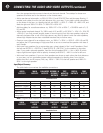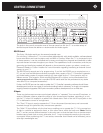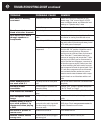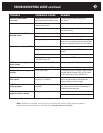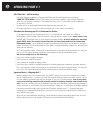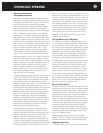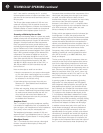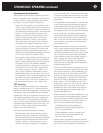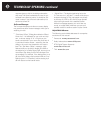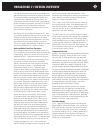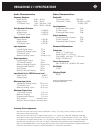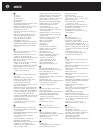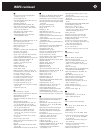
TECHNICALLY SPEAKING continued
60
the C 1 are used for connecting the C 1 to wired
infrared repeater sensors or system controllers. Note
that the main and remote zones each have their own
IR input jacks.
The IR input jacks accept standard
1
⁄8" (3.5 mm) two-
conductor mini-plugs, with the positive wired to the
plug’s tip and the negative to its sleeve. Your Authorized
Parasound Dealer or custom installer can recommend
a compatible infrared repeater system for the C 1.
Preventing or Minimizing Hum and Buzz
Audible hum and buzzing noises in a system are usually
related to issues with the component grounds. Ground
(sometimes called common) is a point of reference for
voltages in virtually all audio and video components.
Every component has its own ground reference, and
the audio signal swings positive and negative in relation
to that. Problems occur when components with slightly
different grounds are connected together. Such “ground
loops” allow unwanted voltages to flow between the
components. This causes an audible hum at the fre-
quency of the local power line (60 Hz in the U.S. and
many other countries, 50 Hz in Europe and elsewhere).
Harmonics of the power-line frequency (120, 240,
and 480 Hz in 60-Hz countries such as the U.S.A., or
100, 200, and 400 Hz in 50-Hz countries) may add
buzz to the hum.
Here are three tips to avoid hum and buzz:
1. Keep the components in your system close togeth-
er, with their power cords plugged into a common
AC outlet or power strip, to avoid problems created
by resistance in the house’s wiring.
2. Use balanced input and output lines with your
Parasound C 1. (See Balanced and Unbalanced
Lines in this section).
3. When rack mounting, always use insulated “shoul-
der” washers. These break the ground loops caused
by metal-to-metal contact between the rack, the
units, and their rack-mount bolts. Washers are
included in Parasound rack mount kits, and extras
are available from Parasound.
Headphone Circuit
The C 1 includes a high-quality headphone amplifier.
It is suitable for headphones with an impedance of 8
ohms or higher; with headphones of lower impedance
(if any exist), volume may be unacceptably low.
The headphone jack accepts a standard
1
⁄8" (3.5 mm)
stereo mini-jack. If your headphones have a
1
⁄4" jack, you
will need a stereo
1
⁄4" jack-to-stereo
1
⁄8" mini-plug adapter.
Video Signal Formats
The C 1 can handle the three common video signal
formats: composite video outputs, S-Video, and
component video.
Composite video combines all the components of the
video signal and passes them through a two-conduc-
tor cable. It therefore offers the least vivid and
detailed video images. It is, however, the most widely
used home video connection standard, largely
because it is the oldest. In the C 1, composite video
input signals are fed only to the composite video out-
puts. RCA connectors, usually yellow, are used
almost universally for this format.
S-Video, which uses separate wires for luminance (pic-
ture brightness – in effect, the signal portions that
make a black-and-white picture) and chrominance (color
information). Keeping these picture elements separate
reduces interactions between them and produces a
cleaner, more detailed picture than composite video. It
also requires the use of connectors with four pins, two
each for the luminance and chrominance circuits.
Component video, which requires three cables is
capable of handling all current high-definition televi-
sion (HDTV) formats, up to 1080i (1080 lines, inter-
laced), and beyond.
The key to the high quality of component video con-
nections are that they include separate links connec-
tions for the video signal components of luminance
(Y) and color difference (Cb and Cr) rather than trans-
mitting them mixed together and separating them out
later. (Not every source component or video monitor
labels its component video Y, Cb, and Cr; some may
label their connections as be Y, B–Y, and R–Y or Y, Pb,
and Pr. Refer to the owner’s manual of your video
component for details.)
A growing number of video components, (including
large-screen TVs, video projectors, and DVD players)
have component video connections, and you’ll get the
best possible picture quality if you use these connec-
tions. However, you will need both a component video
source (the C 1 has inputs for three such sources) and a
TV or projector with component video inputs, as the
C 1’s component video board is isolated from its other
video circuitry. Component-video systems commonly
use RCA or twist-on BNC connectors, with BNC offering
a slight edge in picture quality; the C 1 has BNC jacks,
and comes with adapters for cables with RCA plugs.
In addition to these three jacks, which you’ll find on
home theater components, and some professional
video gear may have RGB connections, which use
separate cables for red, green, and blue, plus external
connections for horizontal and vertical sync signals (or,
sometimes R, G and B plus a composite sync), as do
the VGA video inputs and outputs on computers; the
five jacks on the component video inputs and output of
the C 1 can be connected to these components, too.



